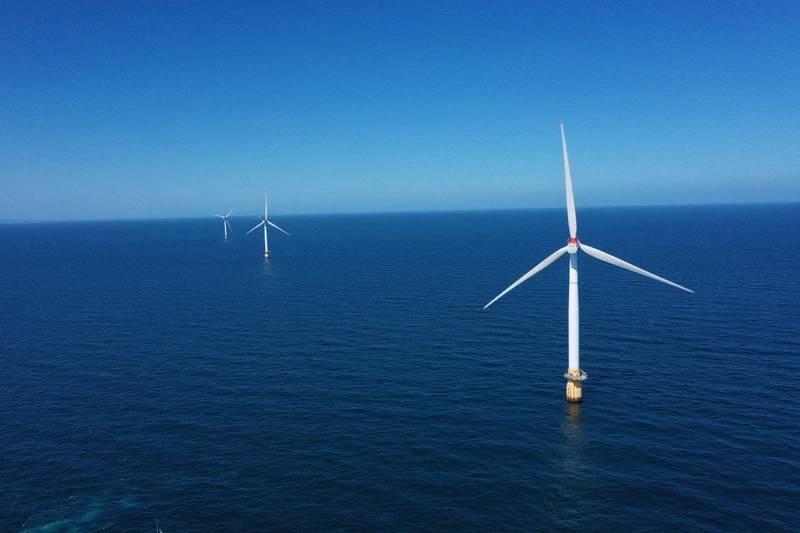Markets: The Challenges of Developing Floating Wind at Scale
Tens of gigawatts of floating wind projects are slated for development in this and the next decade, but many obstacles remain.
There has been much focus on the emerging floating wind market of late.

The U.K. is forging ahead with commercial scale floating wind developments through the Scotwind and INTOG awards of at least 24 gigawatts (GW) of floating wind capacity representing close to 1,500 floating turbines that will come on stream through 2030. And this will be soon followed by the award of at least 4 GW of capacity through the Celtic Sea floating wind auctions. The U.S. has awarded floating wind leases with a potential of over 8 GW of capacity in the Pacific and will move ahead with large floating wind leases in the Atlantic this year. Norway is planning to award 1.5 GW of floating wind capacity at Utsira Nord this year and France is targeting bring 750 megawatts (MW) of floating turbines on stream at the end of the decade in the Atlantic and Mediterranean.
Spain and Portugal are entering the fray with announcement of multi-gigawatt floating wind aspirations. In Asia Pacific, developers are navigating their path through a complicated permitting framework, where the prize is over 8 GW of floating project potential, mostly off the east coast Usan region. Australia and Japan are also the subject of much interest. This is not an exhaustive list of countries with floating wind aspirations, but a selection of the most discussed.
This all sounds very positive – tens of gigawatts of floating wind projects driving demand for suppliers and contractors in this and the next decade. However, many obstacles remain to delivering on these aspirations. This article goes on to discuss some of these challenges that must be addressed:
- Permitting: A feature of offshore wind is the disconnect between aspirational targets and what is realistically achievable in terms of leasing and permitting. An example is Portugal, which has till now permitted less than 100 MW of offshore wind capacity, yet plans to auction, permit and deploy 10 GW of mostly floating wind by 2030. While it is realistic to expect Portugal to award leases for 10 GW by 2030, it is an optimistic timeline to permit, build and deploy the capacity within the time frame.
- No one standard technical approach: Although most projects will deploy one of three broad concepts to support the turbine, a semis-submersible (V-column or barge), spar (buoy or hanging counterweight) or tension-leg platform (TLP), there is an ever-growing number of technical solutions being offered. This drives the need for flexibility in the supply chain.
- Industrialized substructure manufacture: Using the example of permitting applications for U.K. floating wind projects, developers are seeking design envelope approval for structures with footprints of up to 15,000 square meters. We expect to see substructures in the 5,000-10,000 square meter range. The substructures will weigh each weigh a minimum 3-5,000 tonnes if made from steel and up to 20,000 tonnes if made from concrete. On a 1 GW wind farm, over 60 of these will be required in, most likely a two-year delivery window.
- Ports: Deep draft ports will be required to assemble, launch, support turbine integration, store and maintain structures that will feature turbines with rotor diameters over 220 meters. Floating wind ports will likely host large submersible barges, to transfer and launch substructures, as well as some extremely large quayside cranes, of which there is currently insufficient supply.
- Turbine supply: Three western OEMs currently dominate the market outside of China: GE, Siemens Gamesa and Vestas. We anticipate the rise of Asin OEMs, and particularly the Chinese OEMs who are developing 16-18 MM turbines, which only push the potential size of structures even bigger.
- Dynamic cables: Floating wind projects will feature subsea cables, and particularly the inter-array cables that connect the turbines, that are different in nature to bottom-fixed wind. New manufacturing capacity is required. Installation of these cables will also call on the subsea fleet, which is increasingly occupied in the oil and gas segment.
- Floating substations: Till now only one floating substation has been demonstrated. Although the concept should be familiar to developers of deepwater oil and gas projects, new concepts are required.
- Installation vessels: It is often said that floating wind projects require “small” and readily available tugs to support installation. This is not the case. The highest bollard pull anchor handlers featuring the largest clear back decks and biggest chain lockers will be a minimum requirement for many floating wind projects and may even be considered technically inefficient. A new asset class concept suitable for floating wind projects is emerging. These feature bollard pulls in well in excess of 300 tonnes, back decks over 1,200 square meters, AHC cranes with a minimum 250 tonnes capacity and chain clockers to accommodate multiple mooring spreads. It is hard to see these vessels being financed and built in numbers without firm commitments to long-term deployment. To date, we have not seen such commitments.
- Major component repair and exchange: Do you tow the structure to port for maintenance as has already been done with one pilot array? Do you maintain in-situ with either floating cranes or turbine mounted cranes, for which there are currently limited technical options? This is a question that the industry is working on but still needs further development.
The floating wind segment presents a great opportunity to advance renewable energy supply and support the offshore and marine industry. But many challenges still need to be addressed to make projects and new supply chain investments financeable and realizable.
